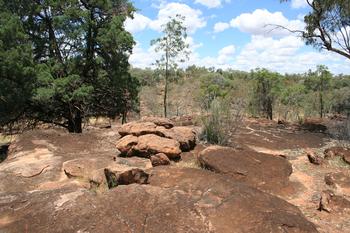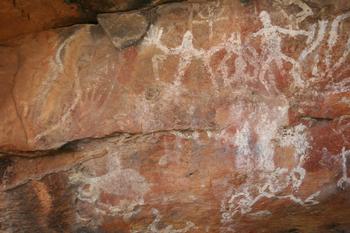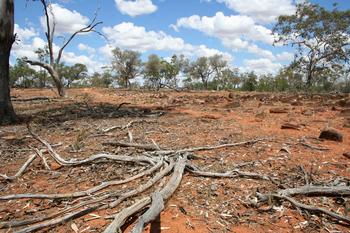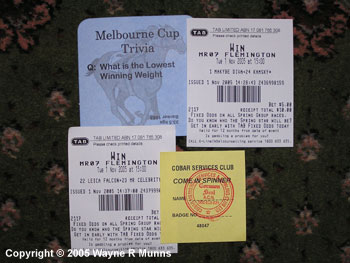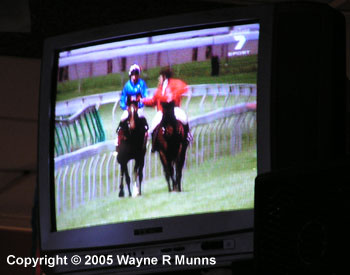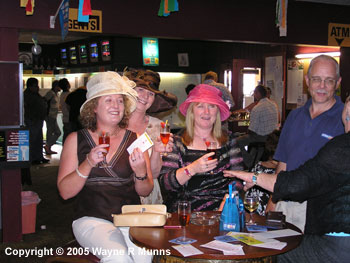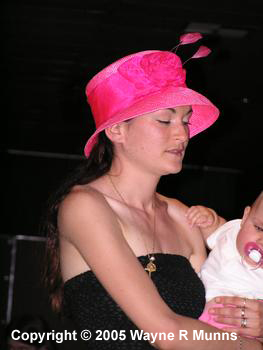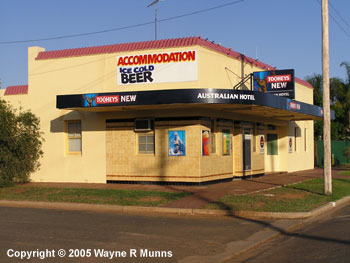| A | U | S | T | R | A | L | I | A | 2 |
0 |
0 |
5 |
 |
 |
 |
 |
Total: 2155 |
Nov 1 |
 |
Mount Grenfell-Melbourne Cup
I woke up this morning, and as I got out of bed I thought I had that balance disorder problem again, and immediately felt sea sick. As I went to turn on the light I remembered we were sleeping in the dugout Motel, and though reasonably flat, the floor was never level. Phew.
After our usual start of 8am bread cheese and sausage breakfast, and a 9am lunch of long blacks and pies, we spent the morning on a 90 mile an hour chase across the outback. We don't pass another car in 200 miles.
We do pass some road trains, which are considerably longer and taller than our 18-wheelers (there's effectively two trailers instead of one) everything else here is on a more modest scale. None of the buildings are more than two floors except in the very largest towns, (and even there the exceptions are only in the extreme downtown area). The average house size is very much more modest—the sort of thing Americans were building in the 50s and 60s. Despite the amount of space, plots tend to be English scale—most houses seem to be on quarter or eighth acre lots, even when they are out in the boonies. Instead of them being lit up like Christmas trees, the default is for them to be dark. Even when you turn the light on in your room, one is constantly looking around for more sources of light. It quickly gets you into the spirit of being frugal. But the resource we've been most affected by is water. The sticker on the sink in this room says "Please... shorter showers and plugs in basin" and there are often instructions in the room on how to conserve.
Oh yeah. We find a sort of morning show, that features a roving reporter describing the "party frocks" which a commentator advises "should be classy if you are going to misbehave" (apparently the only thing worse than a drunk is one in a see-through blouse—or was that the other way around?). Exactly on time, we roll into Cobar with about an hour to spare. First we get gas, and ask where we'll find beer and betting. Two blocks down (in other words on the other side of town). Wayne wrote this in my diary:
As Richard sorts out his camera media issue, I listen to a semi-karaoke play music from the 70s and 80s, something that seems to capture the imaginations of Cobarians, and others I've met in Oz. Lot's of folks seem to live in America's past music-wise. The Cobar Memorial Services & Bowling Club is devoted mostly to gambling (Keno, Pechekol? racing) with its central betting/payout booth and socializing in an alcohol-assisted fashion. A perfect setting to watch the cup. Nice hats abound, but likely nothing like what's in Melbourne today.
So we have a couple of beers, and figure out how to place a bet. Wayne studies the form carefully, and bets on two horses he likes the sound of: Leica Falcon and Mr Celebrity. Makybe Diva is a huge favorite with both the bookies and the crowd, (she'll win for a record third time) so I place $5 on her, and $5 on a 200-1 outsider (in other words, both the most and least likely winners). It's a terrific race, with Mr Celebrity out front from the start, but the favorite comes from behind in the last furlong and takes it. She pays for the beer.
|
|
|
|
|
Cobar The most interesting of the town's buildings include the Great Western Hotel (1898) in the main street which has the longest pub balcony in New South Wales. The pub's timber verandah with cast-iron balustrades and lacework balcony is100m long! The Big Beer Can is located in Cobar – the acknowledged largest beer can in the world, measured by the Guinness Book of World Records at a whopping 5m tall and a 2.5m diameter. The Upper Western region is known for its fine Aboriginal art works. Outside Cobar at Mount Grenfell Historic Site are some of the finest examples of rock art in Australia. There are three main rock shelters with over 1,300 richly colored images including human and animal figures, within an easy 500m walk from the car park. There are also excellent examples of hand stencils which are made when the hand is placed on the rock and ochre is blown over the hand. There are also some interesting abstract linear designs. These displays, most of which are applied with either fingertip or brush, are regarded as some of the best examples Aboriginal rock art in New South Wales. Aborigines were drawn to the site by a semi-permanent waterhole in what was an otherwise arid area. Head along the Barrier Highway for 40km towards Wilcannia then take the signposted turnoff along a good gravel road to the picnic-barbecue-toilet area 32km from the highway. Mount Grenfell Historic Site provides an outstanding opportunity to get a glimpse of the long history of Aboriginal people in the area. The semi-permanent waterhole in this very arid region provided an ideal meeting place for local Aboriginal groups. The adjacent rock ridge offered natural shelter and here, among the outcrops, you can see some magnificent examples of rock paintings. The paintings, which are of ceremonial significance and help to maintain the traditions and myths of local Aboriginal people, were made by dabbing wet pigment with a finger tip or with a simple brush. Ochres and white pipe clay were applied thickly and allowed to dry. In some places later paintings have been superimposed, creating layers of multicolored panels. In addition to linear paintings and designs there are human figures and birds such as emus, which are easily recognizable, mammals and reptiles, and intriguing stick figures. There are also examples of hand stencils, made by blowing mouthfuls of pigment over a hand held against the rock face. The land and waterways, and the plants and animals that live in them, feature in all facets of Aboriginal culture – including recreational, ceremonial, spiritual and as a main source of food and medicine. They are associated with dreaming stories and cultural learning that is still passed on today. |
||
Then on the next town, Nyngan, for a night stop. A typical day. 300 miles or so of driving, and two attractions. Wayne observed in the note book that we've been doing a lot of driving, and not spending much time in the places we've stopped, which is true, but I'm not sure how we'd fix that. It is a long way between sites and sights. I don't feel like we're rushed when we're in a particular place—to take today as an example, we certainly spent as long as we wanted at the caves, and the two reasons for stopping in Cobar were completed in fine style—so I'm quite happy with the pace. Of course, with more time we'd find more things to do, but we set out to get a flavor of the life on this road, and we allowed a week to do it. I think we're doing that. Actually I was far more frustrated with the things we left on the plate in Tasmania.
She leaves, the wash finishes, I transfer the load to the dryer, feed in the coin, and nothing happens. I do it several more times. Nothing. I rummage around behind the machine, all seems to be connected, and switched on. I have no choice but to sit with the damp laundry and wait for Wayne to return. Before he does, the proprietress returns. "Oh," she says "these dryers are so inefficient they have to be connected to the cheap rate circuit, and that switches off at 5:00pm." Excellent.
We return to our digs, hang the washing on the line in the back yard, then head out to the RSC, where because it is between 6 and 8:00pm we're pretty certain of getting a meal. Which we do. This club is well patronized in every room, but perhaps that is because it is cup day. I had sweet and sour pork, the dish of the day which was therefore a big plate of food plus a salad for ~A$10. It reminds me of institution food, but at the price one cannot, and does not, complain. Plus they serve Tooheys Black, so we're in good shape. By 9pm we're all in, and retire to our digs, where I buy one more just to be sociable. Our hosts outnumber the patrons in the bar, but it still is one of the patrons who gets up to serve me. I like that sort of familiarity, but we're too tired to sit and shoot the bull.
